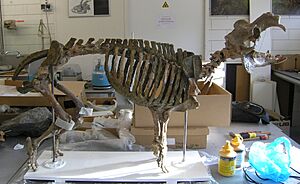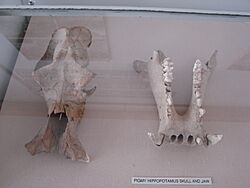Cyprus dwarf hippopotamus facts for kids
Quick facts for kids Cypriot pygmy hippopotamus |
|
|---|---|
 |
|
| Composite mounted skeleton of H. minor | |
| Scientific classification | |
| Genus: |
Hippopotamus
|
| Species: |
minor
|
| Synonyms | |
|
|
The Cypriot pygmy hippopotamus (Hippopotamus minor) was a small type of hippopotamus that lived on the island of Cyprus a long time ago. It lived from the Pleistocene to the early Holocene periods. Even though it was small, about the size of a modern pygmy hippopotamus, it was actually a relative of the much larger common hippopotamus. Its small size happened because of something called insular dwarfism, which means animals on islands sometimes become smaller over many generations. This little hippo was one of only two large land mammals on Cyprus, the other being the Cyprus dwarf elephant. It disappeared around 12,000 years ago, which was around the time humans first arrived on Cyprus. Scientists have found clues that suggest humans might have hunted these hippos.
Contents
Discovering the Little Hippo
For hundreds of years, people on Cyprus found strange bones in the mountains. As far back as the 1400s, locals thought these bones belonged to holy people. Later, in the 1500s, some even believed grinding the bones into powder could cure sickness. In 1698, a traveler named Cornelis de Bruijn drew pictures of bones he found, thinking they were from the Biblical great flood. Today, we know these bones were actually from the Cypriot pygmy hippopotamus!
The first scientific description of this animal was made in 1822 by a French scientist named Anselme Gaëtan Desmarest. He gave it the name Hippopotamus minor. Another scientist, Georges Cuvier, gave it a similar name, Hippopotamus minutus, a few years later, but Hippopotamus minor is the name we use now. For a while, scientists didn't know where these bones came from. But in 1901, a British paleontologist named Dorothea Bate collected more bones from Cyprus. This helped other scientists realize that the bones found earlier also came from Cyprus.
Today, we have found bones of the Cypriot pygmy hippopotamus in over 20 different places across the island. In 1972, some scientists suggested a new name, Phanourios minor, after a local saint. However, most scientists still use Hippopotamus minor because they believe this small hippo came from the same family as the common hippopotamus.
How the Cypriot Pygmy Hippo Evolved
Scientists have studied the DNA of the Cypriot pygmy hippopotamus. They found that its closest living relative is the large common hippopotamus (Hippopotamus amphibius). These two species likely separated from a common ancestor about 1.3 to 1.5 million years ago.
It's not certain exactly which ancestor of the common hippopotamus first arrived on Cyprus. But we know that Cyprus has never been connected to the mainland by land. This means the ancestors of these hippos must have traveled across the Mediterranean Sea, perhaps by swimming or floating during a rare flood event.
Once they arrived on the island, something interesting happened. Over many thousands of years, these hippos became much smaller. This process is called insular dwarfism. It's a common thing that happens to large animals when they live on islands. They shrink in size because there's less food, fewer predators, and less space.
What the Little Hippo Looked Like
The Cypriot pygmy hippopotamus was the smallest known hippo species. It was about the same size as the living African pygmy hippopotamus. Scientists believe it weighed around 130 kilograms (about 287 pounds). It stood about 70 centimeters (2.3 feet) tall and was about 125 centimeters (4.1 feet) long. This means it was more than 90% smaller than its huge mainland ancestors!
Its skull was also different. The part of its skull that held its brain was much bigger in proportion to its overall skull size compared to the common hippopotamus. Its snout was also much shorter, similar to the African pygmy hippopotamus. It even lost one of its upper teeth, possibly because its skull became shorter.
The teeth of the Cypriot pygmy hippopotamus suggest it ate different types of plants, like leaves and twigs. This is different from modern common hippos, which mostly eat grass. Its diet probably changed depending on the climate.
Scientists have also studied its leg and foot bones. They found that this little hippo was more adapted to living on land than its modern relatives. It had a special way of moving that helped it walk efficiently on the rocky and mountainous land of Cyprus. Its lower legs were shorter, and its bones were stronger. It probably moved slowly and couldn't run very fast.
During the Late Pleistocene period, the Cypriot pygmy hippopotamus and the Cyprus dwarf elephant were the only large mammals on the island. There were only two other native land mammals: the Cypriot mouse and an extinct type of genet. The Cypriot pygmy hippopotamus had no natural predators on the island. Its bones are found in large numbers, much more than the dwarf elephant's bones.
Why the Little Hippo Disappeared
The last known remains of the Cypriot pygmy hippopotamus are from about 13,000 to 12,000 years ago. This is around the same time that the Cyprus dwarf elephant also disappeared. It's also when the first humans arrived on the island of Cyprus.
At a place called Aetokremnos on the southern coast of Cyprus, scientists found over 200,000 bones of these pygmy hippos. These bones represent more than 500 individual animals. They were found with human tools and artifacts, dating back to about 13,000 to 12,000 years ago. Some scientists believe this suggests that the early human settlers on Cyprus hunted these hippos, leading to their extinction.
However, not all scientists agree. Some point out that there aren't many clear cut marks on the bones that would show they were butchered by humans. They suggest that the bones might have gathered there naturally over many years, and humans just happened to live at the site later.
A study from 2024 looked at how many dwarf hippos lived on Cyprus when humans arrived, estimating around 14,300. The study suggested that if humans hunted more than 650 dwarf hippos each year, the species would be at risk. If they hunted over 1,000 hippos per year, extinction would be almost certain. This could have happened quite quickly after humans settled on Cyprus, possibly leading to their disappearance around 12,000 to 11,000 years ago.
See Also
- Cretan dwarf hippopotamus
- Maltese dwarf hippopotamus
- Sicilian dwarf hippopotamus
- Cyprus dwarf elephant


